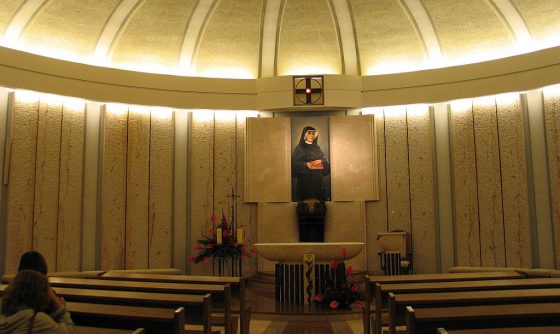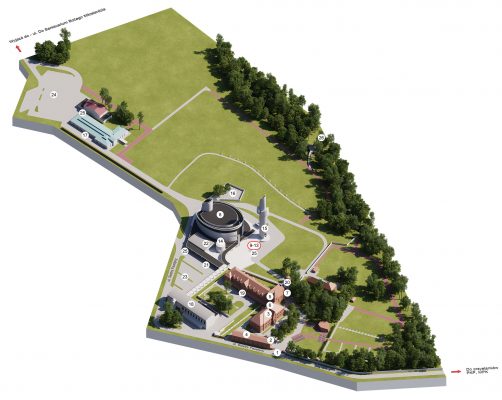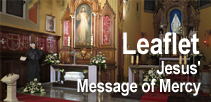We have put a map of the Shrine after the text.
In the lower part of the Basilica there are five beautiful chapels set in a radial arrangement. Each has an interior decoration presented as a gift from the Church of one of the European countries. The Chapel of St. Faustina is in the central position, and its interior decoration is a gift donated by the Bishops of Italy (hence its alternative name, “the Italian Chapel”). Behind the altar there is a tabernacle in the shape of a flower about to blossom, alluding to the words of St. Faustina, who wrote that God’s love is the flower, and mercy is its fruit (Diary 949). Over the tabernacle there is a picture of St. Faustina holding her Diary. The picture, by Jan Chrząszcz, is superimposed on a reredos shaped like an open book. A reliquary in the shape of a rose containing a relic of St. Faustina is mounted in front of the altar. The altar, pulpit, and the plinth of the reliquary are made of travertine in a pale shade, while the walls are overlaid with slabs of Polish sandstone. The floor has a radial pattern alluding to the arrangement in the top level of the Basilica and the rays in the picture of the Merciful Jesus, symbols of all manner of graces. The Chapel was consecrated on the centenary jubilee of St. Faustina’s baptism by Cardinal Camillo Ruini, President of the Bishops’ Conference of Italy. The Italian Chapel also contains the Holy Picture of the Merciful Jesus which went on a peregrination, visiting all the parishes in the Archdiocese of Kraków, the Diocese of Tarnów, and the Diocese of Bielsko Biała and Żywiec.
Sister Faustina is one of the greatest mystics in the history of the Church. Jesus called her His Secretary and Dispenser of Divine mercy, entrusting her with the prophetic mission of disseminating the message of Mercy throughout the world. Following His instructions, she has brought a new school of spirituality into the history of the Church. It is a spirituality based on the mystery of Divine mercy, and its characteristics are discovering God through the mystery of mercy, contemplation in the midst of everyday life, and hence an attitude of trust in God and merciful love of one’s neighbour. The other features which supplement this school of spirituality are love of the Church, the Eucharist, and devotion to Our Lady of Mercy. St. Faustina’s school of spirituality shares many features in common with other schools of spirituality, but stand out in her spiritual practice for their characteristic emphasis on mercy.
St. Faustina’s school is deeply rooted in the Gospels, attuned to the same foundations of Christian doctrine (trust in God and mercy for one’s neighbour), which makes it universal, addressed and accessible to all people regardless of their station in life, social or any other circumstances. It is the school of spirituality followed by today’s Apostles of the Divine Mercy, who are spreading the message of God’s merciful love to all people.
- Main entrance to the Shrine
- Sister Faustina’s House: hotel & museum
- Convent
- Antoninek House: Faustinum Association
-
Merciful Jesus Chapel & Saint Faustina’s Tomb: Heart of the Shrine
- Oratory: room where Saint Faustina died
- Chapel of the Lord’s Passion
- Divine Mercy Basilica
- Saint Faustina’s Chapel
- The Communio Sanctorum Chapel
- Saint Andrew’s Chapel
- The Holy Cross Chapel
- The Chapel of Our Lady of the Seven Sorrows
- Perpetual Adoration Chapel
- Viewing Tower
- Convent Graveyard
- Sister Faustina’s House: restaurant, souvenirs & meeting hall
- Pastoral Lodge: hotel & restaurant
- Mercy House
- Information Booth
- Souvenirs & Misericordia Bookshop
- Saint John Paul II Hall
- Car park
- Car and coach park
- Toilets
- Bridge of Mercy, for the Saint John Paul II Shrine & tram stop

















